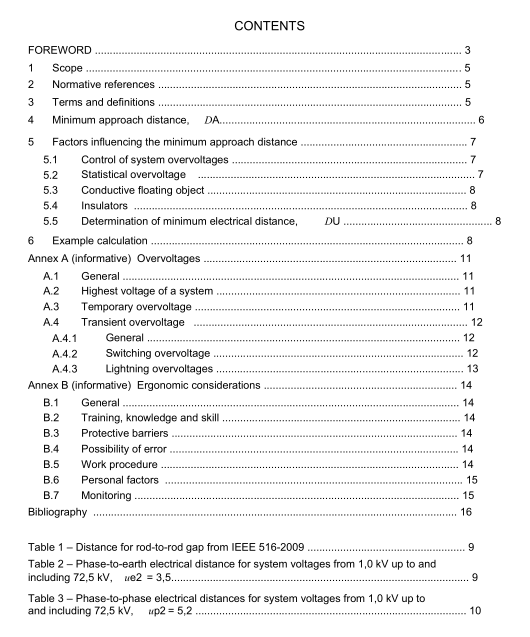IEC 61472-2 pdf – Live working – Minimum approach distances – Part 2: Method of determination of the electrical component distance for AC systems from 1,0 kV to 72,5 kV

IEC 61472-2 pdf – Live working – Minimum approach distances – Part 2: Method of determination of the electrical component distance for AC systems from 1,0 kV to 72,5 kV
1 Scope
This part of lEC 61472 specifies a method for determining the electrical component of theminimum approach distances for live working, for AC systems 1 kV up to and including 72,5 kV.
This document addresses system overvoltages ‘and the working air distances betweenequipment and/or workers at different potentials.
The withstand voltage and minimum approach distances determined by the method describedin this document can be used only if the following working conditions prevail:
– workers are trained for,and skilled in,working live lines or close to live conductors or
equipment;
the operating conditions are adjusted so that the statistical overvoltage does not exceed thevalue selected for the determination of the required withstand voltage;
transient overvoltages are the determining overvoltages;
– tool insulation has no continuous film of moisture present on the surface;- no lightning is observed within 10 km of the work site;
– allowance is made for the effect of the conducting components of tools.
NOTEIn some counties,special procedures have been developed to permit live working with surface moisture ontools at distribution voltages (below50 kV).
2Normative references
There are no normative references in this document.
3Terms and definitions
For the purposes of this document, the following terms and definitions apply.
ISO and IEC maintain terminological databases for use in standardization at the followingaddresses:
. IEC Electropedia: available at http://www.electropedia.orgl
.Iso Online browsing platform: available at http://www.iso.org/obp
3.1
highest voltage of a systemUs
highest value of operating voltage (phase-to-phase voltage) which occurs under normaloperating conditions at any time and any point in the system
Note 1 to entry: Transient overvotages and permanent induction from adjacent lines are not taken into account inthe calculationformula
[SOURCE: lEC 60050-601:1985,601-01-23, modified – the symbol
us and the words “(phase-
to-phase voltage)” have been added, and Note 1 has been revised.]
3.2
transient overvoltage
short duration overvoltage of a few milliseconds or less, oscillatory or non-oscillatory, usuallyhighly damped
[SOURCE: IEC 60050-614:2016,614-03-14]
3.3
nominal system voltage
suitable approximate value of voltage used to designate or identify a system[SOURCE: lEC 60038:2009,3.1]
3.4
per unit statistical overvoltage phase-to-earthle2
phase-to-earth per unit overvoltage that has a 2 % probability of being exceeded
3.5
per unit statistical overvoltage phase-to-phaseup2
per unit overvoltage that has a 2 % probability of being exceeded
3.6
statistical overvoltageU2
overvoltage that has a 2 % probability of being exceeded
3.7
minimum approach distanceDA
minimum electrical and ergonomic distance in air to be maintained between any part of the bodyof a worker, or any conductive tool being directly handled, and any live conductors or equipmentat different potentials
3.8
electrical distanceDu
electrical component of the minimum air distance between two electrodes which represent liveand/or earthed conductors or equipment, required to prevent sparkover under the most severeelectrical stress that will arise under the chosen conditions
3.9
ergonomic distanceDE
distance in air added to the electrical distance, to take into account inadvertent movement anderrors in judgement of distances while performing work
[SOURCE: IEC 60050-651:2014,651-21-13, modified – the symbol DE has been added.]









